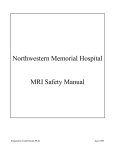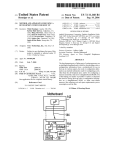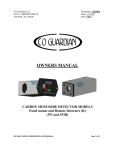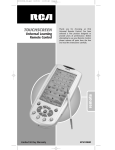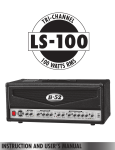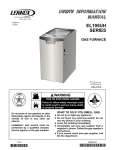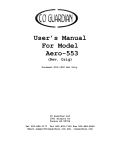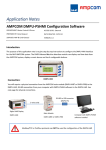Download iMFD 650 User Manual
Transcript
Forever sniffing for hidden dangers to keep aviators safe… Table of Contents Record of Revisions ........................................................................................................ 4 Foreword ......................................................................................................................... 5 Basic Functions ............................................................................................................... 6 System Description ......................................................................................................... 6 Pin Layout FMS 650 ...................................................................................................... 11 Installation of 2 Amp CB ................................................................................................ 11 Installation of FMS 650.................................................................................................. 11 Maintenance Instructions .............................................................................................. 13 Emergency Procedures ................................................................................................. 15 Warranty........................................................................................................................ 16 Supplement 1 – Aero-Medical Aspects ......................................................................... 18 FMS 650 -1 Owner‟s Manual Page 3 of 21 Record of Revisions Revision No Page No. Date A 1 - 26 07/15/14 FMS 650 -1 Owner‟s Manual Description Initial release Approved by Ash Vij Page 4 of 21 Foreword “Carbon monoxide (CO) is a colorless, odorless, and tasteless gas that is ... toxic to humans... when encountered in higher concentrations.” - Wikipedia This owner‟s manual is intended to be used by persons who, pursuant to current requirements, are qualified to install the FMS 650, cockpit carbon monoxide monitoring and warning system. Since different aircraft have differing cockpit layouts and have differing installment specifications, this document is not designed to be a type specific installation manual but a generic installation guideline. In case you require any specific information about the FMS 650, please contact us at the address below Guardian Avionics CO Guardian, LLC 1951 E. Airport Drive Tucson, AZ 85756 (520) 889-1177 520-889-8249 (Fax) [email protected] http://www.guardianavionics.com While every care has been taken in the preparation of this document, any errors, inconsistencies or suggestions may be forwarded to us at the address given above. Please refer to the document page number and name. List the details of the error and / or inconsistency and suggested changes to the document. FMS 650 -1 Owner‟s Manual Page 5 of 21 Basic Functions Feature Description Carbon Monoxide (CO) detection The system generates an alarm when the CO level rises above 50 parts per million (PPM) and stays above this level for 3 min 30 seconds. The alarm operates without any delay in case the CO level rises above 100 PPM. Data is transmitted via an RS 232 port and a remote warning light is switched on in case of CO crossing threshold levels. CO warning light This light will be switched on when the CO level is detected above the designated threshold. GAV Alert Llight This caution light will alert the pilot at preset cabin altitudes of 10,000 feet, 12,500 feet and 14,000 feet AMSL. Tone generator FMS 650 generates a tone and sends it to the aircraft audio panel whenever an alarm condition exists. Data transfer FMS 650 unit interfaces with the RS 232 data bus and is able to access a large number of aircraft parameters. This data can be transferred via a Bluetooth connection to as many as six iOS devices simultaneously. These devices include iPhones and iPads. Check our website for the latest applications. Real time instrument data accessibility via Bluetooth Data transferred via Bluetooth (see above) can be viewed in real time over iPhones or iPads inside the aircraft. Visit our website for the latest application. Remote reset The unit can be reset remotely either by a hard wire reset or via the RS232 data stream. USB Power The unit has two USB ports. These can provide 2.1 Amp power each to two smart USB devices. In case the unit is connected to a non-smart switch, it will be able to provide 1 Ampere continuous power supply. System Description 1.0 General Carbon Monoxide (CO) can be dangerous in an enclosed space such as an aircraft cockpit. The FMS 650 is designed to be installed in the instrument panel of an aircraft. It is designed to detect the presence of CO concentrations before they reach life threatening levels. In addition, the FMS 650 can connect to the RS232 data stream and provide real time engine and GPS data to FMS 650 -1 Owner‟s Manual Page 6 of 21 occupants in the aircraft who may be using iPad(s) or iPhone(s). The data can later be uploaded to a secure cloud based server. 2.0 Physical Description Dimensions (all in inches) 3.0 FMS 650 -1 Owner‟s Manual Leading Particulars Page 7 of 21 Parameter Value / Specification Dimensions 7 (length) x 1.3 (height) x 1.8 (width) (in inches) Weight 8 oz Cooling Passive Temperature range Non operational temperature range -55 C to +85 C Operational temperature range -20 C to +55 C Humidity range 5% to 95% (non condensing) Power requirements 14 V DC Model +14 V DC (nominally 9.0 V to 15.1 V DC) 28 V DC Model +28 V DC (nominally 18.0 V to 30.3 V DC) System start up and stabilization time One minute Power utilization (both 14 V and 28 V models) 2 Watts without any device charging through the USB ports 25 Watts with two devices charging through both USB ports with firmware control USB charging Both the ports are in Auto-Detect mode and their charging current is limited to 1 Amp. These ports can deliver up to 2 Amps when under firmware control. 14 V @ 1.8 Amp 28 V @ 0.9 Amp On board storage Up to 2 GB onboard storage on device is possible. Enabled via optional purchase through the App store. Certification SAE 412B Connectivity Connectivity 2 x RS232 serial outputs FMS 650 -1 Owner‟s Manual Page 8 of 21 5 x RS232 serial inputs Bluetooth - Range 100 feet line of sight. Can connect up to six devices. Basic system comes configured for two devices. To connect 2 / 4 more devices, an upgrade is required to be purchased via the App store. 4.0 5.0 Scope The FMS 650 family of Carbon Monoxide detectors is designed to carry out a number of functions that go on to make a flight safer, better managed and more interesting. The system performs the following functions – Maintaining a continuous watch over the levels of carbon monoxide in the cockpit and generating timely alerts to warn pilots of elevated CO level. The system is capable of providing a warning on most cockpit multi-function displays (MFD). Monitoring the cabin altitude and alerting the pilot on reaching cabin altitudes of 10,000 feet, 12,500 feet and 14,000 feet Access all data that is available on the RS232 bus and display it on a special FMS 650 App that runs on the iPhone / iPad Use the iPhone / iPad to transfer aircraft performance data to cloud based storage (once the device has network connectivity) Store aircraft performance data on its internal 2 GB storage Provides a USB charger for up to two devices in flight Carbon Monoxide level monitoring and warning The system monitors the carbon monoxide content in the air in the cockpit and generates an alert under the following conditions – If the carbon monoxide concentration reaches 50 parts per million (PPM) or more, an alert is generated within 5 minutes FMS 650 -1 Owner‟s Manual Page 9 of 21 The alert delay is reduced at higher concentrations of carbon monoxide. At 100 PPM, the alert is nearly instantaneous. The alert is displayed on the pilot‟s instrument panel MFD. An audio warning is also generated that is supplied to the pilot‟s headset. See our website for the latest list of MFD manufacturers that the FMS 650 can integrate with. The alert will stay „ON‟ on the pilot‟s instrument panel MFD until the level of CO concentration drops below 50 PPM. In addition to the warning being displayed on the MFD, the large, green lamp on the face of the FMS 650 will turn yellow within five minutes if the CO level is detected to be in the region of 50 to 100 PPM. If the level crosses 101 PPM, the lamp will turn red without any delay. 6.0 Cabin Altitude monitoring and warning FMS 650 has an in-built pressure sensor that monitors the cabin altitude of the cockpit. As the cabin altitude increases, the system becomes more sensitive to the presence of CO in the cockpit. Besides this, the system warns the pilot if the cabin altitude exceeds preset values. The indications are as given below – On cabin altitude exceeding 10,000 feet, the GAV Alert caution lamp comes on for a short period to alert the pilot. On cabin altitude exceeding 12,500 feet, the GAV Alert caution lamp comes on continuously after a time delay of 30 minutes. On cabin altitude exceeding 14,000 feet, the GAV Alert caution lamp comes on immediately. These warnings will come on even if the carbon monoxide level in the cockpit is absolutely normal. 7.0 Service Facilities (all models) The operator can service all other components of the installation at an FAA certified Repair Station or by an A&P mechanic. CO Detectors must me be returned to CO Guardian for repair, calibration or overhaul. The sensor life is 5 years from date of installation. FMS 650 -1 Owner‟s Manual Page 10 of 21 Note The sensor requires special gases for testing. If any discrepancies are found with the unit during installation or during the operational service life, the unit must be returned to CO Guardian for repair or replacement. The CO Detector unit must be returned to the manufacturer for CO sensor replacement and re-calibration at the end of the service life as applicable to the specific unit in use. Pin Layout FMS 650 See FMS 650-2 Installation Drawing for latest available hook-ups. Installation of 2 Amp CB A 2 Amp circuit breaker will need to be installed for the FMS 650. A typical install is shown in the figure. The CB should ideally be mounted on the Essential Bus that will not be automatically isolated in the event of a generator failure. The CB must be properly annotated or labeled as shown in the figure. Ensure that the power and ground return wires are twisted together at 6 or more turns per foot. Connect Pin 1 of the FMS 650 unit to +14 V DC or +28 V DC as applicable to the aircraft and the type of FMS 650 voltage rating through the 2 Amp CB installed for the unit. Connect the ground return wire (Pin 5) to a suitable aircraft structure near the CB panel. The CB will provide power supply to three components – Pin 1 of FMS 650, the CO warning light and the optional GAV Alert caution lamp. Installation of FMS 650 8.0 Basic Requirements The following basic requirements have to be insured while installing FMS 650 FMS 650 -1 Owner‟s Manual Page 11 of 21 9.0 Choose a location on the instrument panel that can be accessed by both pilot and co-pilot Ensure that the airflow to the unit is not restricted Ensure that the location selected for installation is not subjected to dust or dirt Ensure that the air intake on the front of the unit is not obstructed or blocked in any manner Ensure that the unit is not exposed to a strong airflow. The sensor performs better if it is not subjected to strong airflow Ensure that the unit is used within the temperatures and humidity restrictions as mentioned in the leading particulars (page 7). Mounting FMS 650 FMS 650 is to be mounted behind the instrument panel as shown below. 10.0 Post Installation Checks (a) With the CO Detector disconnected from the aircraft harness, conduct a continuity check of the added aircraft wiring. (b) Turn ON the aircraft Battery Switch. Close the CO DETECT circuit breaker and measure aircraft voltage between pins 1 and 5 of the CO Detector connector. FMS 650 -1 Owner‟s Manual Page 12 of 21 (c) Put aircraft Battery Switch OFF. Connect the CO Detector connector to the aircraft harness. Turn aircraft Battery Switch ON. Close CO DETECT circuit breaker. (d) Verify that the unit can be shut off with the CO DETECT circuit breaker. (e) Determine the moment arm for the installed CO Detector location and record in aircraft weight and balance manual. CO Detector weight is 8 oz approximately. 11.0 RS232 DATA BUS OPTION The RS232 Data Bus option is currently available on numerous MFD units. The RS232 data bus output will couple FMS 650 status information to electronic display systems with RS232 input capability. If this is done, any warnings generated by FMS 650 will be displayed on the MFD (see the diagram on page 9). More detailed information on managing the RS232 interface and connecting other devices such as the FMS 650 will be available in the installation manual of the MFD. In some cases, FMS 650 can be be reset through the RS232 interface (if the MFD system in use supports this feature). 12.0 Bluetooth Connectivity FMS 650 incorporates a Bluetooth chip that can integrate with any electronic device that supports Bluetooth. Once paired with such a device such as an iPhone or the iPad, FMS 650 unit will connect automatically everytime it is powerd up. If the paired device has the optional Pilot FMS App loaded then data from the RS232 data bus can be displayed on the iPhone / iPad and be transferred to the cloud for secure storage. Real time engine data, flight information, CO levels, GPS data and the pilot and airframe logbook can all be managed from the App. If the unit is not being detected by the Bluetooth of your iPhone / iPad, go to Bluetooth setting on iPhone / iPad, select 'forget this device' and try to reconnect again. Maintenance Instructions The CO Detector unit has its own internal built in test mechanism and every time it is powered up, it conducts a self diagnostic test. In case the device fails the test, this is FMS 650 -1 Owner‟s Manual Page 13 of 21 indicated by the warning lamp blinking red after the equipment is switched ON. If the equipment clears the built in test the warning lamp will stay green. Field repairs are permissible on all components of the CO Detector except on the CO Detecting element and its indicator. In case these components are found faulty, the unit must be returned to CO Guardian, LLC for service / repair. The aircraft wiring harness, circuit breaker, alert annunciation, and Test/Reset switch shall be included in the aircraft maintenance instructions for general visual inspections for system integrity, installation security, corrosion and chaffing. 13.0 Scheduled Maintenance The following scheduled maintenance program tasks are to be added to the aircraft operator‟s airplane maintenance program - Maintenance Task Periodicity Recommended Periodic Scheduled Servicing Tasks: None required Recommended Periodic Scheduled Preventative Each time the unit is Maintenance test/checks to determine system condition turned ON and/or latent failures: Note: Be sure the vent on the faceplate is free of obstructions. Recommended Periodic Inspections: None required Recommended Periodic Structural Inspections None required Required CO Sensor replacement and calibration. At the end of service life (5 years from date of installation). The Unit must be returned to Guardian Avionics at the end of Service Life for replacement and calibration of the CO sensor to maintain airworthiness of the unit. The main reason for replacement of the sensor is the degradation of the sensor and dirt accumulation over the years. Field service or overhaul of models is NOT authorized. 14.0 Weight and Balance FMS 650 weighs 8 oz / 0.5 lbs. The moment arm for the equipment will need to be calculated from the aircraft weight and balance manual. FMS 650 -1 Owner‟s Manual Page 14 of 21 15.0 Limitations FMS 650 is not designed to replace any existing instrument or indicator required by the type design or operating limits. 16.0 Self Test When power is applied to the FMS 650 CO detector, a self-test routine begins. The test checks for functionality of the critical components such as the CO sensor, temperature and pressure sensors, and the integrity of the total CO Detector system, including the Bluetooth system. When all systems clear the self test, the warning lamp on the FMS 650 instrument turns and stays green. In case any component fails the test, the warning lamp will turn red and blink. Emergency Procedures If the CO Detector ALERT annunciation activates in flight: Shut off the heater, air conditioning or any other opening to the engine compartment. Open a fresh air source immediately. Don't smoke. Use 100% oxygen, if possible. Land as soon as conditions permit. Be sure the source of the contamination is corrected before further flight. Note: the alert message on the MFD will stay ON till the CO level stays above 50 parts per million (PPM) by volume of carbon monoxide concentration. DO NOT recycle the unit via the circuit breaker since FMS 650 will need one minute for the CO sensor to stabilize after each power up. 17.0 Unit Failure A failure of the CO Sensor, Temperature Sensor, or the Micro-controller will result in the warning lamp coming on. However, there will be no indication on the MFD, nor will there be any audio warning generated. In case of failure indications, attempt to clear the failure by resetting FMS 650 via the CB. If the failure indication persists or recurs, remove the power supply to the unit by pulling the circuit breaker for the system. FMS 650 -1 Owner‟s Manual Page 15 of 21 Warranty WARRANTY COVERAGE: CO GUARDIAN LLC. WARRANTS TO THE ORIGINAL CONSUMER PURCHASER, THAT THE FMS 650 CO DETECTOR WILL BE FREE OF DEFECTS IN MATERIAL AND WORKMANSHIP FOR A PERIOD OF ONE (1) YEAR FROM DATE OF PURCHASE. THE MANUFACTURER'S LIABILITY HEREUNDER IS LIMITED TO REPLACEMENT OF THE PRODUCT, REPAIR OF THE PRODUCT OR REPLACEMENT OF THE PRODUCT WITH A REPAIRED PRODUCT AT THE DISCRETION OF THE MANUFACTURER. THIS WARRANTY IS VOID IF THE PRODUCT HAS BEEN DAMAGED BY ACCIDENT, UNREASONABLE USE, NEGLECT, TAMPERING OR OTHER CAUSES NOT ARISING FROM DEFECTS IN MATERIAL OR WORKMANSHIP. THIS WARRANTY EXTENDS TO THE ORIGINAL CONSUMER PURCHASER OF THE PRODUCT ONLY. Warranty Disclaimers: Any implied warranties arising out of this sale, including but not limited to the implied warranties of description, merchantability and fitness for a particular purpose, are limited in duration to the above warranty period. In no event shall the Manufacturer be liable for loss of use of this product or for any indirect, special, incidental or consequential damages, or costs, or expenses incurred by the consumer or any other user of this product, whether due to a breach of contract, negligence, strict liability in tort or otherwise. The manufacturer shall have no liability for any personal injury, property damage or any special, incidental, contingent or consequential damage of any kind resulting from gas leakage, fire or explosion. Some states do not allow limitations on how long an implied warranty lasts, so the above limitation may not apply to you. Some states do not allow the exclusion or limitation of consequential or incidental damages, so the above limitations or exclusions may not apply to you. Legal Remedies: This warranty gives you specific legal rights and you may also have other rights that vary from state to state. Warranty Performance: During the above warranty period, your product will be replaced with a comparable product if the defective product is returned, postage prepaid, to CO Guardian, Customer Service Department, 1951 East Airport Drive, Tucson, AZ 85756, together with proof of purchase date. Please include a note describing the problem when you return the unit. The replacement product will be in warranty for the remainder of the original warranty period or for six months whichever is longer. Other than the cost of postage, no charge will be made for replacement of the defective product. Important: Do not attempt to open unit. If unit is opened, warranty will be void. Your Carbon Monoxide Alarm is not a substitute for property, disability, life or other insurance of any kind. Appropriate insurance coverage is your responsibility. Consult your insurance agent. FMS 650 -1 Owner‟s Manual Page 16 of 21 NOTE The warranty will be void if the unit is opened or tampered with. For installation see latest installation drawing @ www. guardianavionics.com. FMS 650 -1 Owner‟s Manual Page 17 of 21 Supplement 1 – Aero-Medical Aspects 18.0 Effects of Carbon Monoxide on the human body Even small concentrations of CO in Hemoglobin (Hb) (the active component of red blood cells in the human blood) can have an impact on human health. The table below shows the impact of increasing concentrations of COHb. % COHb Effect 10 No symptoms. Heavy smokers can have as much as 9% COHb. 15 Mild headache. 25 Nausea and serious headache. Fairly quick recovery after treatment with oxygen and /or fresh air. 30 Symptoms intensify. Potential for long term effects especially in the case of infants, children, the elderly, victims of heart disease and pregnant women. 45 Unconsciousness 50+ Death Symptoms vary widely based on exposure level, duration and the general health and age of an individual. The symptoms most significant in the recognition of carbon monoxide poisoning include: headache, dizziness and nausea. These 'flu like' symptoms are often mistaken for a real case of the flu and can result in delayed or misdiagnosed treatment. If you experience these symptoms and your CO detector alarm is sounding, a potentially serious buildup of carbon monoxide exists. 19.0 Effect of Cabin Altitude on Individuals “Hypoxia (also known as Hypoxiation or Anoxemia) is a condition in which the body or a region of the body is deprived of adequate oxygen supply”, Wikipedia. The effects of hypoxia on a given person cannot be accurately predicted. For example, a person may be relatively unaffected one day, but highly susceptible the next. It is difficult to detect hypoxia, because its victims are seldom able to judge how seriously they are affected, or if they are affected at all. The unpleasant sensations experienced in suffocation are absent in the case of hypoxia. Blurring of vision, slight shortness of breath, a vague, weak feeling, and a little FMS 650 -1 Owner‟s Manual Page 18 of 21 dizziness are the only warnings. Even these may be absent or so slight as to go unnoticed. While still conscious, the aviator may lose all sense of time and spend his/her last moments of consciousness in some apparently meaningless activity. In such a condition, a person is a menace to the crew as well as to himself. Since the aviator understands that it is the reduced air pressure at higher altitudes that determines the effect on the body, dependence should be upon the altimeter rather than sensations or judgment to determine when oxygen is needed. The effects of hypoxia at various altitudes are discussed in the following paragraphs. Below 10,000 Feet - At or below 10,000 feet, some effects of hypoxia may be present. Generally, the eye is the first part of the body to suffer effects of hypoxia. Even at a relatively low altitude of approximately 5,000 feet, where no other effect of hypoxia can be detected, night vision is appreciably reduced. At 10,000 feet, night operations may be seriously handicapped by poor night vision, which is due to mild oxygen starvation. Thus, the use of supplemental oxygen on night flights above 5,000 feet is required. Although hypoxia affects the eyes in the daytime as well as at night, the results during the day are usually not as noticeable below 10,000 feet. Between 10,000 and 15,000 Feet - Although efficiency may be considerably impaired at 10,000 to 15,000 feet, death from oxygen starvation at these altitudes is virtually unknown. The greatest dangers are from errors in judgment or performance due to drowsiness or mental confusion. At these altitudes, long flights without oxygen produce persistent drowsiness and excessive fatigue for many hours afterward. Frequently, persistent headaches develop soon after completion of the flight. For these reasons, the use of oxygen on flights above 10,000 feet is required. Portable oxygen systems are available for aircraft that do not have oxygen equipment. Between 15,000 and 20,000 Feet - Flights at 15,000 to 20,000 feet, even for short periods, must not be attempted without the use of oxygen. Collapse and unconsciousness are common. Failure to use oxygen could result in death, especially when the situation is complicated by loss of blood in combat or by shock due to pain or fear. Between 20,000 and 25,000 Feet - During World War II, most military flying was done in unpressurized aircraft at altitudes of between 20,000 and 25,000 feet. Most of the resulting anoxia deaths occurred in this altitude range. The general symptoms of drowsiness, mental confusion, dim vision, and dizziness occur here, as at lower altitudes, but they come on much more quickly, allowing less opportunity for corrective action. Consequently, under no circumstances should aircraft ascend to these altitudes, even for short periods, without the use of oxygen by all persons aboard. The movement of personnel in the aircraft requires the constant use of walkaround equipment. The above data is from http://www.tpub.com/content/aviation/14020/css/14020_141.htm FMS 650 -1 Owner‟s Manual Page 19 of 21 20.0 Time of Useful Consciousness “Time of useful consciousness (TUC) is defined as the amount of time an individual is able to perform flying duties efficiently in an environment of inadequate oxygen supply. It is the period of time from the interruption of the oxygen supply or exposure to an oxygen-poor environment to the time when useful function is lost, and the individual is no longer capable of taking proper corrective and protective action. It is not the time to total unconsciousness. The TUC has also been called Effective Performance Time (EPT).” – Wikipedia. The table below reflects various altitudes with the corresponding average TUC Flight Level Time of Useful Consciousness FL 150 30 min or more FL 180 20 to 30 min FL 220 5-10 min FL 250 3 to 6 min FL 280 2.5 to 3 min FL 300 1 to 3 min FMS 650 -1 Owner‟s Manual Page 20 of 21 FMS 650 -1 Owner‟s Manual Page 21 of 21






















